Exam 3 Synaptic Transmission David Fraiser
1/130
There's no tags or description
Looks like no tags are added yet.
Name | Mastery | Learn | Test | Matching | Spaced |
|---|
No study sessions yet.
131 Terms
What are inotropic ion channels?
Ligand-gated ion channels
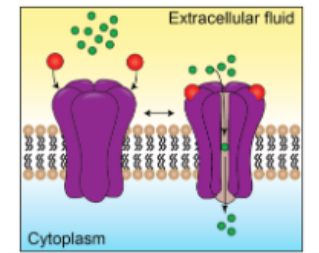
Which are faster, ionotropic or metabotropic receptors?
Ionotropic has rapid onset effects, metabotropic has slow onset effects
What type of relationship do ionotropic receptors have with action and response?
1:1 relationship between action and response
What type of relationship do metabotropic receptors have with action and response?
1:1 Amplification of response by G-proteins and second messengers
What are the scope of effects of ionotropic receptors?
Effects are limited by the type of ion channel that is part of the receptor protein
What are the scope of effects of metabotropic receptors?
Diverse possible effects from a single neurotransmitter due to multitude of second messenger mediated signaling pathways
What concentration of neurotransmitter is used to cause effects in ionotropic channels?
MicroMolar ranges
What concentration of neurotransmitter is used to cause effects in metabotropic channels?
NanoMolar ranges
Where are ionotropic receptors located relative to the site of neurotransmitter release?
Often located near the site of neurotransmitter release
Where are metabotropic receptors located relative to the site of neurotransmitter release?
Often located at some distance from the site of neurotransmitter release
What are the 3 types of metabotropic receptors?
G-Protein coupled, Enzyme Linked, Cytoplasmic receptors
What are G-Protein coupled receptors?
-Ligand binfing of the G protein receptor leads to activation of GTP bidning protein
How common are G-protein coupled receptors?
Lots of receptors, lots of pathways
What are enzyme linked receptors?
Receptor tyrosine kinases, serine/threonine-specific kinases, guanylate cyclase receptors
What triggers kinase cascade (Enzyme linked receptors)?
Ligand binding initiates kinase cascade
What do cytoplasmic receptors do? (basic)
Often target gene transcription
What is an agonist?
A compound that elicits the same biological effect(s) as the endogenous (naturally-occurring) ligand when it binds to a receptor
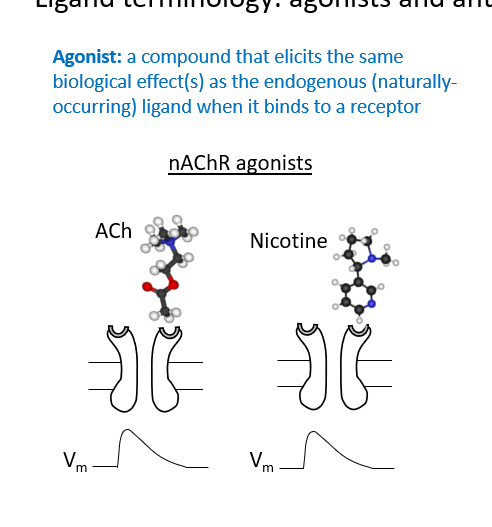
What is an antagonist?
A compound that reduces or eliminates the effect of an agonist when bound to a receptor
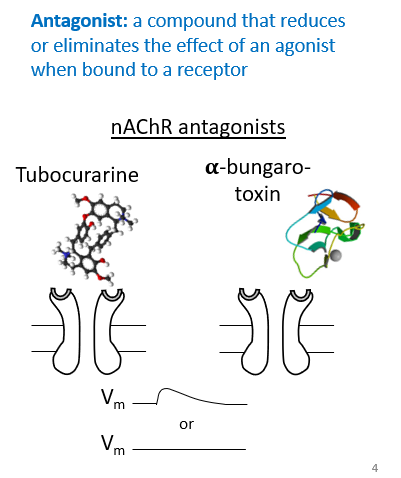
What is a competitive antagonist?
Binds to the same site as an agonist (orthosteric binding) but does not activate the receptor. Reduces or prevents activation of the channel by an agonist.
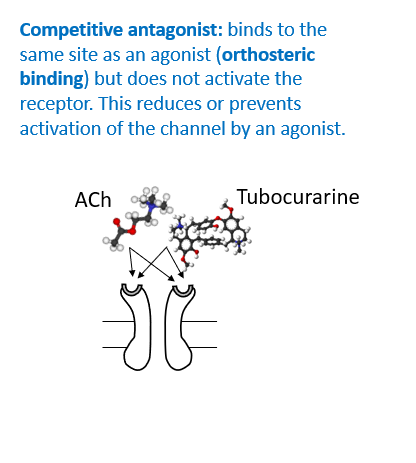
What is a noncompetive anatgonsit?
Binds to receptor at a different sidte from agonist, but prevents or reduces activation. known as a NAM (Negative allosteric modulator)
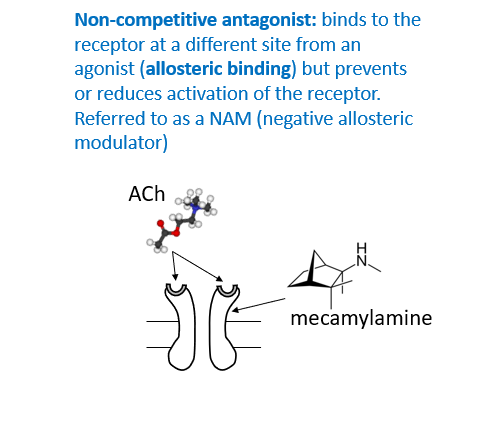
What is a reversible antagonist?
Binds non covalently to receptor
What is an irreversible antagonist?
competing
WHat are the 3 main characteristic of ionotropic recptors?
-Selective ligand binding site
-Selective pores opening
-Equilibrium potential is determined by the electrochemical gradient for permeant ions
What are the 4 main familie sof ionotropic receptors?
-Pentameric (Cys-loop)
-Glumtamine
-Terimeric
-TRP
What are the pentameric receptors?
ACh,5-HY#,GABAa,Glycie,ZAC
What are the strcuture of Penatmeric recptor?
-Share common structure with extracellular loop with 2 cysteine
-M2 segments form the pore
How many subunits and membrane spanning segments do Pentameric receptors have?
5 separate subunits, 4 membrane spanning segments M1-M4
How many and where does acetylcholine bind to on nAChR receptors?
2 molecules of ACh, 2 a subunits
What are the 2 types of subunit combinations for neuronal nAChR subunits

What are the 5 main charcteristic of neuronal AChRs
1) different subunit comp
2) Varrying affinity for Nic and Ach
3) Can pass more caclium than muscle AChRs
4) located presynaptically in CNS
5) suscetpiable to desensitization
Binding of a ligand to a receptor is ______?
Probabilistic
What factors affect ligand binding?
Binding frequency depends on concentration of the ligand, and the amount of time a ligand spends bound to a receptor varies by ligand
What type of ACh receptors does ACh bind, what about nicotine?
ACh=all receptors
Nicotine= Only ionotropic Ach receptors
What is Kd?
The dissociation constant
-Indicates concentration at which 50% of binding sites are occupied
How is Kd calculated?
Ratio of the unbinding rate (K off) divided by binding rate (K on)
What is the relationship between Kd and affinity?
Inversely related
-Therefore a ligand with high affinity has low Kd
-Ligand with low binding affinity for a receptor has a high Kd

What is different between 5-HT3 receptors and other 5-HT receptors
Usually 5-HT receptors are metabotropic, 5-HT# is the exception
Where are 5-HT3 receptors found?
Found in GI tract and brainstem
What are the characteristics of 5-HT3 receptors?
-Nonselective monovalent cation channel
-5 types of subunits A-E (A has binding site_
What type of receptors are GABA, and how many types of GABA are there?
GABA-B are metabotropic
-GABA-A are in pentameric recptor familt with nAChRs; ligand gated chloride channels. Equilibrium arounf -70mv
-Can have a,b,y subunits
How does GABA a affec the cell?
GABA A causes a influx of CL- ions casuing the membrane to become more negative?
What does the GABA diagram look like?
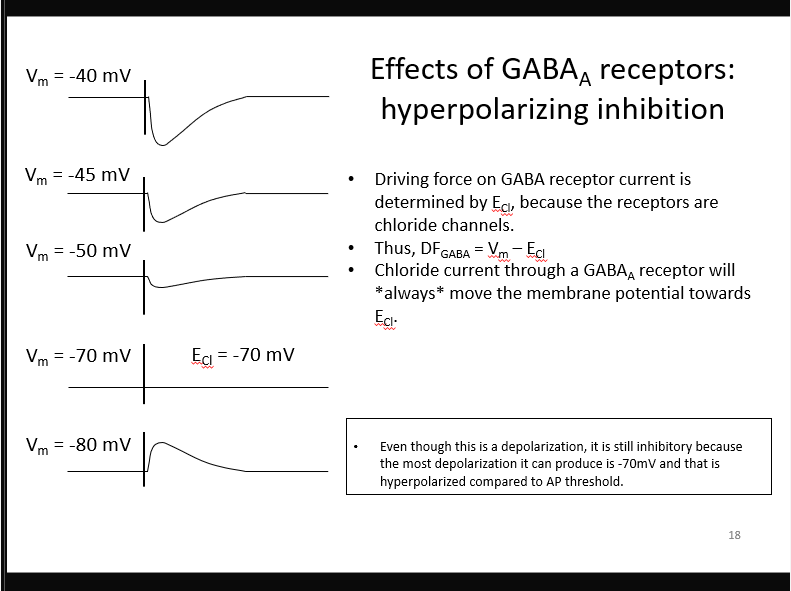
Shunting inhibtion*
What are glycine receptors?
Pentameric receptors, permeant to chloride
What are the differences between glycine and GABA receptors?
Glycine found more in the brainstem and spinal chord (compared to GABA)
Faster channel opening and closing (compared to GABA)
What does Zinc to Gaba and Glutamte receptors?
Zinc can antagonize or modulate other receptors (mostly GABA and Glutamate)
What are Zinc-Activated Channel receptors?
-Proton receptors (?)
-Nonselective monovalent cation channels
-Present in some mammals but not others
What is the most common NT?
50 trillion synapses
What are the ionotropic glutamate receptors characteristic?
4 Subunits
3 Transmembrane domains
Large extracellular loop
What are the characterstics of the loops?
-2 domains that form Pacman
-1st loop (amino terminal domain) sometimes bind antagonists
-Second loop domain (ligand binding domain) binds… glutamate and any antagonists
What is the structure of the inotropic glutamate receptor structure?

What type of iontropic glutamate receptors are there?
NDMA
NON-NMDA
AMPA
Kainate
AMPA and Kainate have ___ conductance
Low
NMDA receptors have ____ conductance
High
AMPA and Kainate have ____ gating speed
Fast
ndma has ____ gating speed
Slow
What ions are permeable to AMPA and Kainate receptors?
NA+ K+ and Ca2+
What ions are permeable in NMDA receptors?
Na+, K+, Ca 2+
What effect does glycine have on NMDARs?
Glycine is a co-agonist
What effect does Mg2+ have on NMDA and non-NMDA recptors
NMDA- Yes Mg2+ block at rest
Non-NMDA- No Mg2+ block
WHat is the structure of NMDA receptors?
2 GluN1 and 2CluN2 subunits
-Glutamate binds to GLUN2 subunits
-Also requires binding of glycine or D-sEine
How does Mg2+ block NMDA glutumate receptors?

What is the diagram for Mg2+ block of NMDA glutumate receptors?

What type of response do AMPA and Kainate receptors have?
Fast and Excitatory
What are the characteristic of AMPA receptors
GLuA1-A4 Subunit types
GluaA2 is the one that blocks calcium, so ones lacking GLUA1 will be permebale to calcium as well as sodium and potassium
-No magnesium block, no glycine needed
What are the characteriscs of Kainate receptors?
-Fast and excitatory
-Less common the AMPA and nmda
-Found in hippocampus, cerebellum, amygdala, retina and spinal cord
-Gluk1-5 subunits
-A little slower than AMPA (but not as slow as NMDA
What us the first signal for metbaotropic receptors?
Extracellular binding of the NT to the receptor
What is the second signal of metabotropic recprors?
The second messenger inside the cell
What was the first identified 2nd messenger? (Metabotropic receptors)
Cyclic AMP
What does Experiemnt 1 of secondary messengers show (hint-adds Epi)
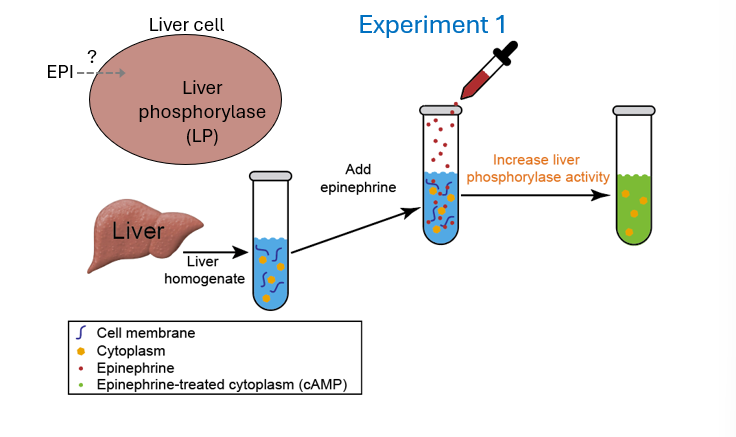
What does Experiment 2 of delivery of second messengers show? (Hint-Membrane)

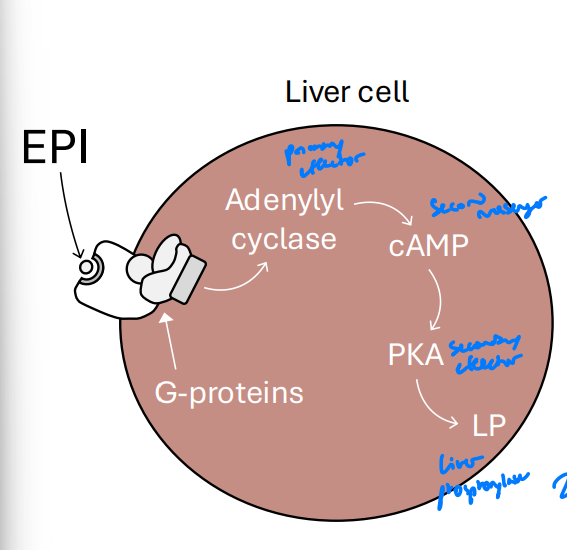
What are the different classsifcations i.e Primary effector, secondary messanger etc.
-Epi=External signal (first messanger_
G-Protein= Transducer
Adenyl Cyclase=Primary effector
What is the first messanger?
Molecule outside cell (ligand)
What is a transducer?
Ex. G protein
connects receptor to effector
Translates signal for outside into an inside signal
Transfers signal from receptor to effector by activating it
What is the primary effector?
Usually an enzyme (i..e adentlyl cyclase, phopholipase)
Produces second messenger
Effector=Enzyme
What is the second messanger?
Small molecule inside the cell
Amplifies and spreads the signal
What is the secondary effector?
the protein that responds to the second messenger (i.e PKA)
Alter cellular activity-enzyme activation, gene expression, secretion
What is the common secondary structure of metabotropic receptors?
7 transmembrane domains
3 extra, 3 intraceullar loops
What happens before the Ligand binds the receptor (metabotropic) (1/3)
G protein is attach to the intter surface of the membrane
Alpha sunuits has GDP bound-meaning its inactive
B and y subunits are bond to Ga
No signal= receptor and G-Protein are both “off”
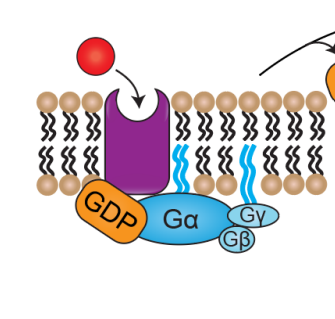
What happens when the Ligand binds the receptor (metabotropic) (2/3)
receptor changes shape
Receptor changes Ga subunit
Subunit release GDP and binds GTP
Ga-GTP seperates from Gby
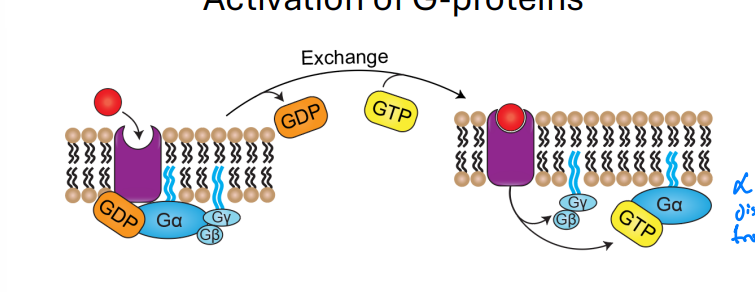
What happens after GTP binds to Ga (metabotropic) (3/3)
activated subunit binds to enzyme (effector)
Enzyme becomes activated and catalyzes second messenger
Gby can modulate ion channels or other effectors
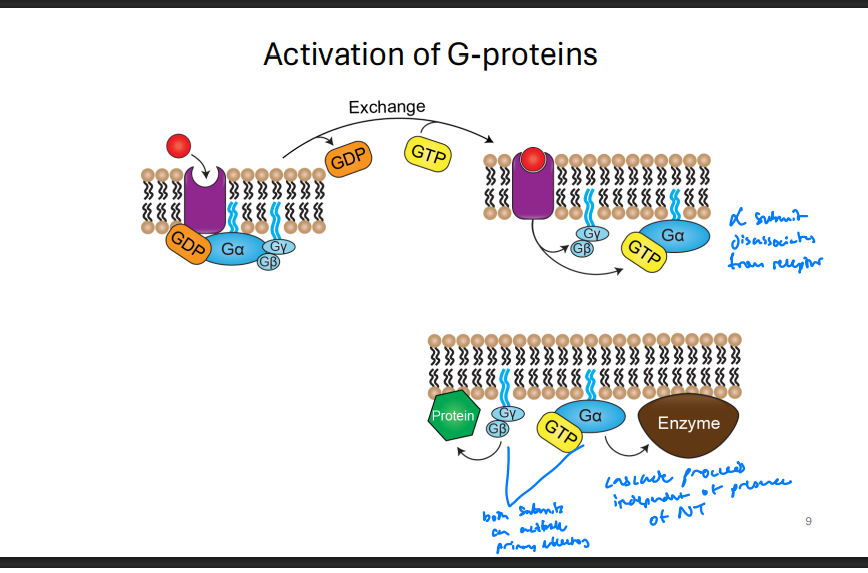
How does the G-Protein complex inactivate
Ga subunit hyrolyzes GTP to GDP
Turns off and allows rejoining Gby, rejoining trimeric state

How does effector interaction affect GTP hydrolysis?
Can speed up hydrolysis

How does regulatory protein effect G-protein signaling?
Regulatory protein accelerates GTPase activity

What to Somatostatin and Acetylcholine do in ocntext of G-prtoein subunits
Somatostatin (SOM) acts via αO1, β3, γ3
Acetylcholine (ACh) acts via αO2, β1, γ4
Combinations used by 2 metabotopic receptor patwhays to jhibit calcium channels
what do Oligonucleotides do?
Degrade mRNA
Can use to knock down specific subunits and study which ones are required for particular receptor
what is the direct pathway? (GCPRs)

What is the cAMP pathway?
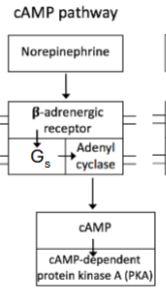
What is the Phosphinositol pathway?
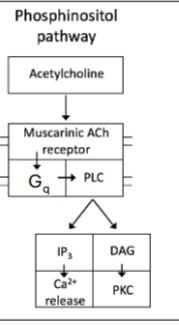
What is the arachidonic acid pathway?
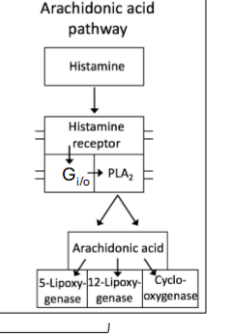
Which G-Protein dimer is involved in moldulating GIRK?
Beta-Gamma dimer activate GIRK channels but Alpha-GTP dimer do not.

What is paired pulse facilitation? “Weak snyapse”
First AP occurs and voltage gated calcium channels are triggered
Some channels open and release NT
Second AP occurs fast enough to use previous calcium activation
More NT is released than first AP causing stronger EPSP
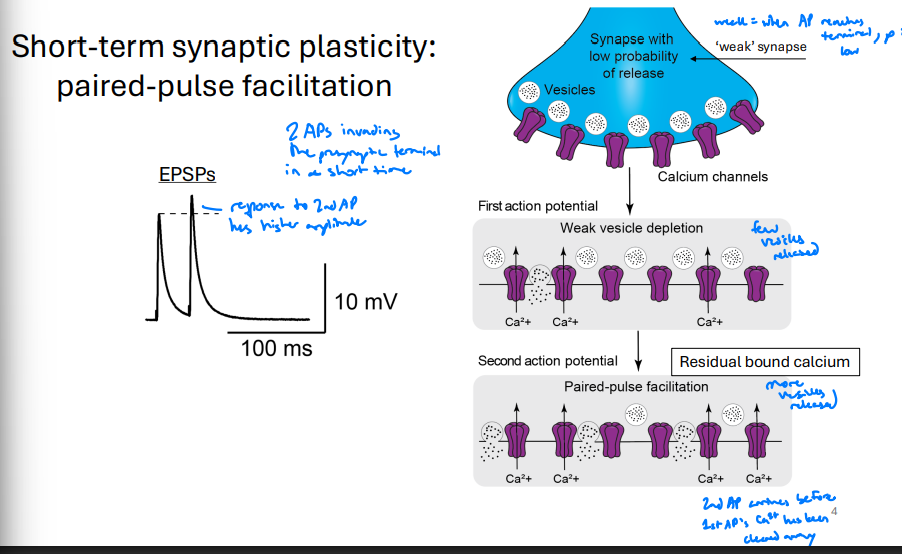
What is paired pulse depression? “Strong synapse”
First AP occurs, and all voltage gated calcium channels are activated
Most vesicles are release from presynaptic terminal
Second AP occurs and there is less available Neurotransmitter
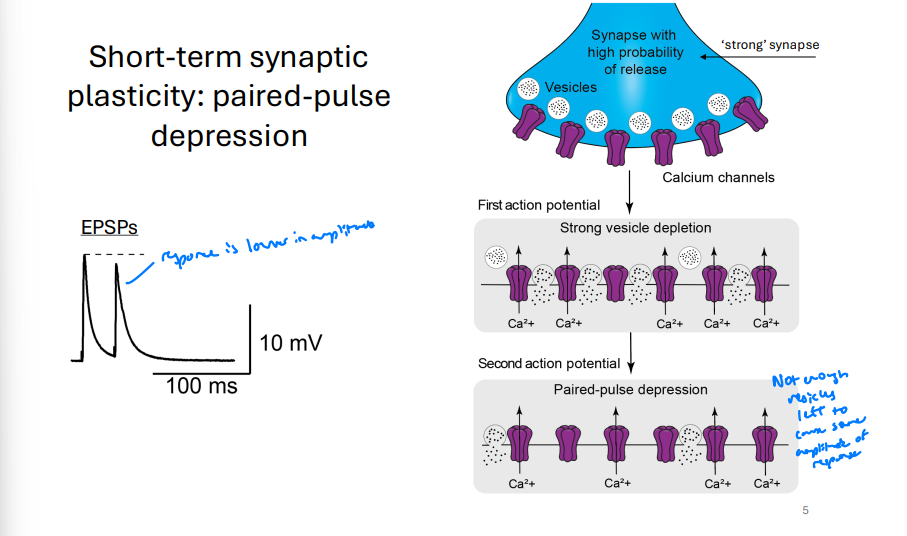
What is tetanic potentiation?
Think Titanic , big and crashing down
More calcium channels are open but less NT available over time
What is a low pass filter?
Strong synapse, tetanic depression
repsonds will to single or few stimulus but losses strneght over time
What is a high pass filter?
weak synapse, tetanic facilitation
Responds will to many action potentials building up calcium precense allowing for more vesicle release
What are the 3 hypothesis about how proteins contribute to short term faciliation?
Buffer saturation
Calcium channel modulation
Synaptotagmin 7
What is the buffer saturation hypothesis?
Paired-pulse facilitation
calcium buffers that soak up calcium are saturated after the first ap, making subsequent EPSP stronger with more calcium and vesicle release
What is the caclium modulation hypothesis for paired pulse facilitation?
Residual Ca2+ interacts with hining proteins which enhance opening of voltage ca2+
When second AP arrives, channels open more easily or stay open longer